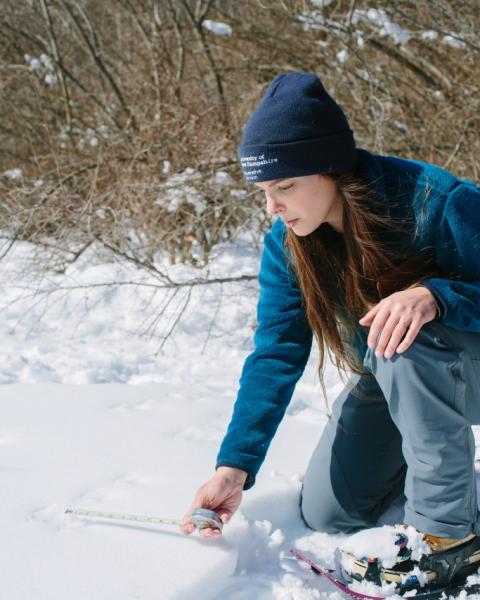Bat Conservation and Forestry

Foresters and other natural resource professionals can help to conserve and enhance bat habitat on managed lands. They can learn about New Hampshire’s bats and management at a June 1 workshop in Sugar Hill. Foresters and wildlife biologists from Native Geographic LLC, N.H. Fish and Game, Natural Resources Conservation Service (NRCS), Ammonoosuc Conservation Trust and UNH Cooperative Extension will lead the full-day workshop and field tour.
Jesse Mohr, licensed forester and consulting ecologist with Native Geographic, is the lead organizer and instructor for the workshop. “One of the things I am most excited about,” Jesse said, “is getting to explore with the other instructors how these practices dovetail with recommendations for birds, forest resilience, best management practices, and generally good forestry.”
Haley Andreozzi, wildlife biologist with UNH Cooperative Extension, asked Jesse about his interest in bats.
Why are you interested in bats?
I have always navigated towards projects, properties, and landowners where I can apply my interests in wildlife biology, ecology and forestry. All northeast bats use habitats common to working forests throughout the summer, so once they all started declining from white nose syndrome about 10 years ago, I started considering them in my inventory and management planning. Like a lot of foresters, I mainly included provisions for snags and cavity trees and other roosting structures.
Tell us about your work on bat conservation and forestry.
Over the last 3 years, thanks to an NRCS Conservation Innovation Grant, I have had the incredible opportunity to spend hundreds of hours surveying for bats and evaluating bat habitats on a variety of working forest properties, which really broadened my perspective on bats and forest management. Of course, all of this time in the woods assessing for bats and bat habitats is grounded in countless hours of trainings, reading scientific publications, and talking to just about any bat biologist that would lend me their ear.
Like many folks working in the woods, I learn best by doing and it was time spent in the woods visiting a variety of silvicultural practices and habitats with my bat detectors, prism, and data collection sheets where I began to see how forestry practices can for better or worse affect bats and the quality of bat habitats. Having administered harvests on a few of the properties surveyed also gave me some insight as to how these harvests could be modified to further benefit bats. Likewise, I was also able to experience the financial and logistical challenges of modifying harvests for bats.
What drives the need for this work?
For me, the need is mostly rooted in biology, but also feeling like bats and working forests can be an ally. Bats are undeniably declining and it sure seems like we are probably going to lose at least one bat species in my lifetime. Because of their population status, I think any conservation-minded individual working in the woods needs to be at least aware of bats and their dependency on our forests.
Perhaps, more poignant to my work, I also think that bats, at least northern long-eared bats (NLEB), and the working forest community really started off their modern relationship on the wrong foot. Prior to the interim NLEB listing, working forests and bats had this silent partnership spanning over a hundred years, a partnership that has more common ground than a lot of the forestry community recognizes. Bats generally benefit from forest heterogeneity at the landscape scale and within-stand heterogeneity, two common by-products of many, though not all, silvicultural practices. NLEB also benefit from robust forest economies, because they ultimately benefit from forests staying forested. Historically, bats were the primary benefactor of this relationship, but it was not entirely one-sided; because of their ability to control some agricultural and forest pests, bats provide an important service to us.
What do you predict for the future of bats and working forests?
I think that recent awareness regarding bat conservation is starting to shift the scales. The presence of NLEB and other declining bat species can be a challenge, but I am increasingly seeing NLEB habitat and NLEB presence being used as a tool to support forest land conservation. Outside of New Hampshire, Indiana Bat has been considered in land conservation for decades. If we are able to look past some of these challenges—granted it is a big look sometimes—I also think bats can be a good tool for the forestry community to convey the importance and value of working forests and keeping our working forest economies and working forest landscapes intact.
What can folks expect to get out of the workshop?
We will learn about bats and the habitats of working forests, looking at habitat management. The morning will be inside and we will be in the field in the afternoon. Discussion will cover how management may impact the function of these habitats and how silvicultural practices can be modified to maintain adequate habitat for northern long-eared bat and other declining bat species. We will also cover practices to conserve and enhance other forest, wetland, and open habitats for bats.

